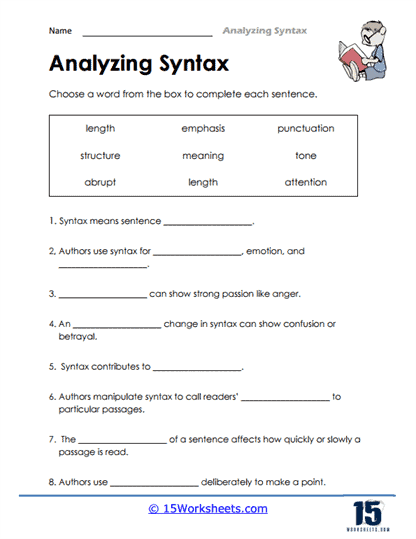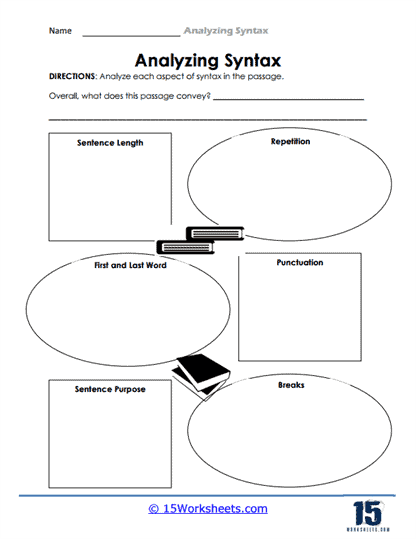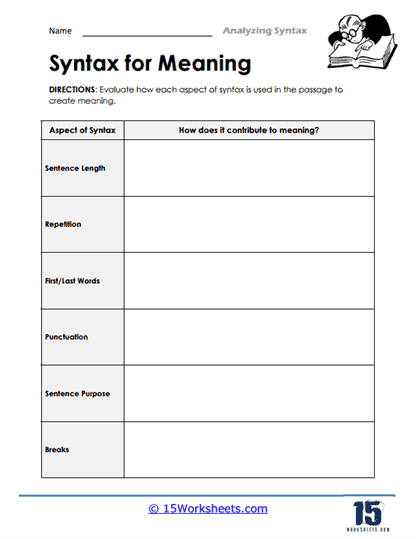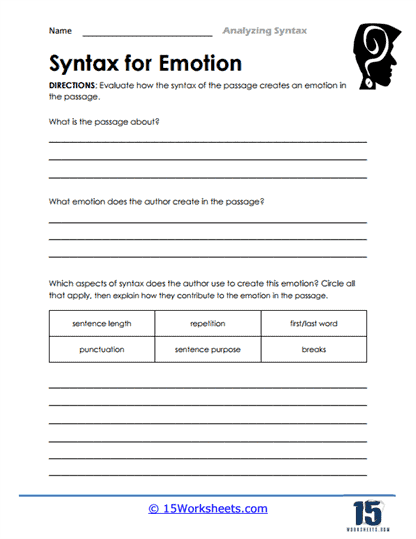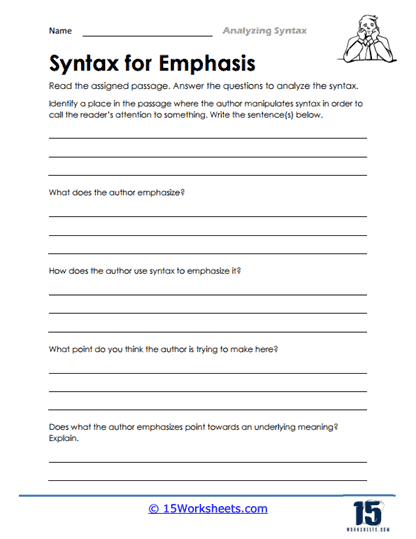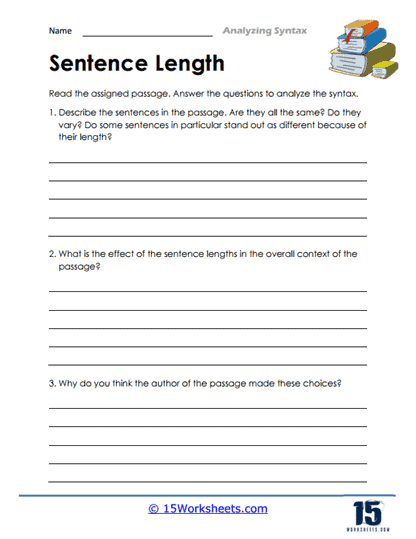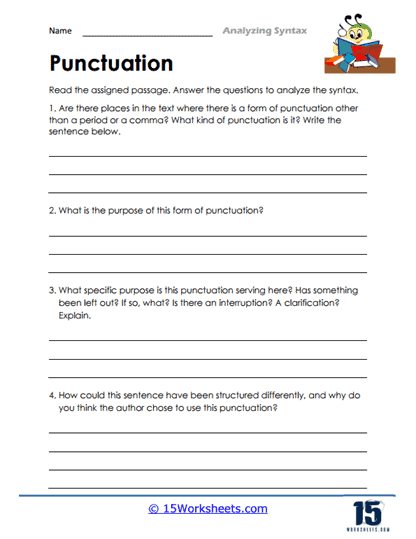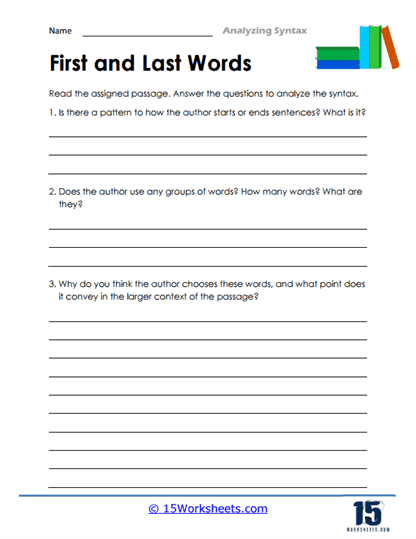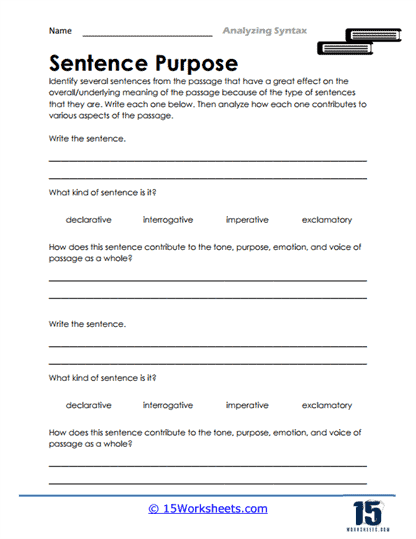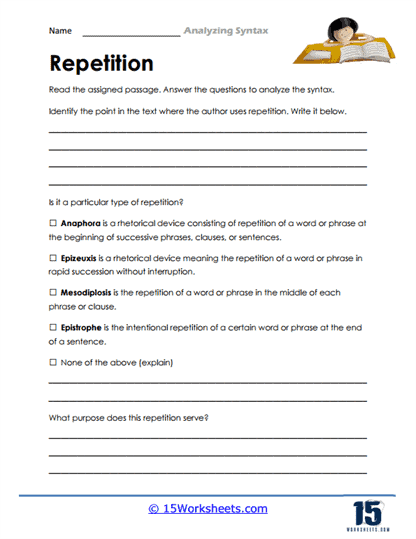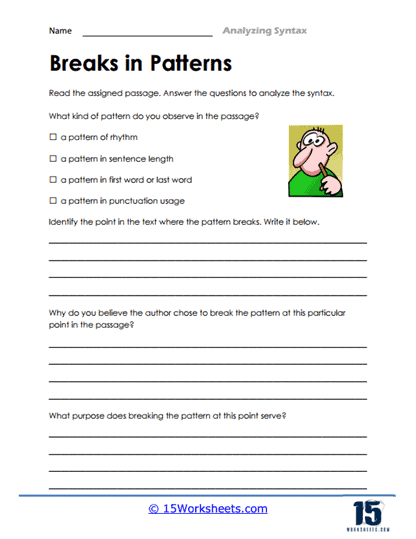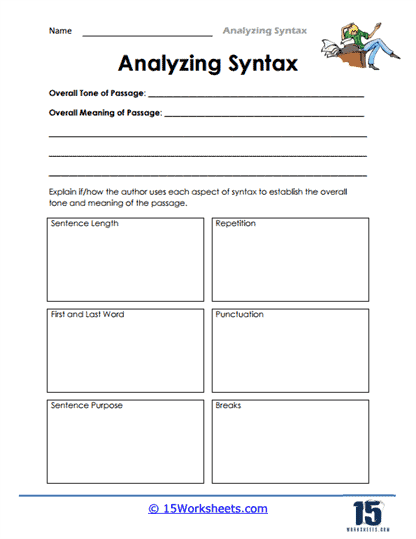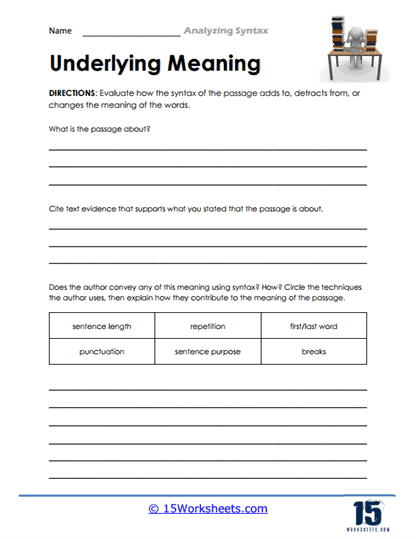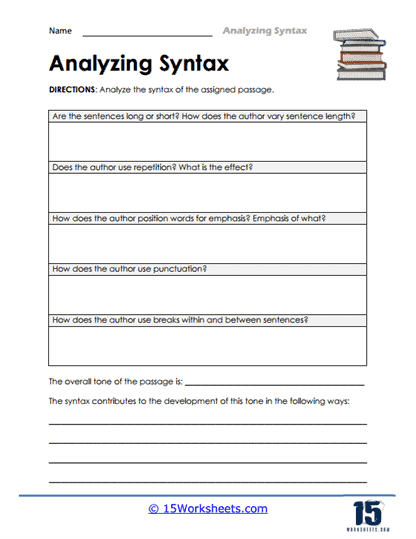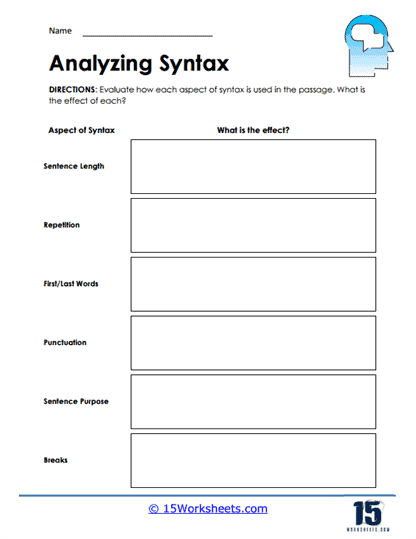Analyzing Syntax Worksheets
All About These 15 Worksheets
This collection of worksheets are designed to help students understand the structure of sentences and how the arrangement of words can affect meaning. These worksheets include a variety of activities that encourage critical thinking and analysis of language. By completing these worksheets, students will:
- Understand how sentence structure affects the overall tone and meaning;
- Learn the different aspects of syntax such as sentence length, repetition, first and last words, punctuation, sentence purpose, and breaks;
- And answer short writing prompts after reading assigned texts or passages carefully.
Overall, these worksheets can help students to develop a deeper understanding of syntax and how it impacts language and communication. By analyzing sentence structure and identifying the different aspects or techniques in syntax, students can improve their ability to read and write effectively, and to appreciate the subtleties of language.
How to Analyze Syntax
There are many different situations where we may need to analyze the syntax of a written work. We could be reviewing our own work or the work of others. Syntax analysis is simply breaking down how the sentences were constructed. The general purpose is to make certain that the arrangement and use of words leaves the greatest impact possible on our audience. The goal is to project our thoughts with the greatest level of effectiveness. These worksheets will help you learn how to analyze the syntax of written works and how to amplify the message that they project.
The study of syntax helps us to understand how language works and how it can be used to create meaning. It also allows us to analyze the ways that writers and speakers use language to achieve their aims. When studying syntax, we look at how words can be arranged to create meaning. This can include looking at the order of words in a sentence and how clauses and phrases are used.
For example, we can use syntax to analyze how a writer uses repetition or parallelism for effect. In addition, studying syntax can help us understand the relationships between words and concepts. By understanding how language is put together, we can gain a greater appreciation for the beauty and subtlety of communication.
No matter your language background, analyzing syntax can be an important tool for improving your writing. By studying the patterns of how words are put together in a sentence, you can more effectively communicate your ideas.
We learn to analyze syntax when we are evaluating a work that we feel can be presented in a more effective way to get an impactful message to the readers. We are attempting to amplify the value of the piece we are evaluating. This is pretty much the job of most editors regardless of what they edit. While there is no set procedure for evaluating syntax, there are general rules that we adhere to. Here are some considerations for you during your evaluation process:
Sentence Length – This is generally a reflection of the audience that the piece is aimed at. Obviously writing for college educated people or second graders will require a vast difference in the sophistication of the sentence lengths. You need to make sure that you have a nice mix of short, medium and long sentences. The longer sentences will be reserved for key points. Avoid any major shifts in sentence length as it will stick out to reader and often result in a fumbled message.
Order of Words – Obviously we want to make certain that the sentences have balanced mechanics, but is there a better way to order the words to result in a greater impact? We want to make sure that in most circumstances the subject comes before the predicate (the main verb).
Beginning of Sentences – We are trying to ensure that there is not an evident pattern to how we start off the sentences. If a pattern exists, we need to add variation. Patterns tend to bore readers and result in lessened effect of the piece.
Maximum Effect – This something that you will become better at with more experience. You want to start out by looking for balance. The main point should be first introduced, then have some evidence provided, and summed up. You do not want that point to be focused towards the front or end of the piece. Providing balance will have a greater impact on your message.
Along with sequential balance you want to maintain the emotion within a passage. This means to stay consistent with your tone. Emphasize things that need to be, if it does not contribute to your central message, do not emphasize it. There are situations where punctuation can be used to heighten the emphasis of just about anything. Dashes and ellipsis can come in handy, at times. They can add stops or pauses to our message. The more you can isolate your idea, the better.
Use of Repetition – This is where we begin the piece as a whole. By this time, we have gone through each of the sentences and created a sense of balance. Now we want to create a stability for the work. The goal here is to make sure that the flow of piece is more like a sailboat than a power boat. Repetition can be a good thing but overused it can be a problem. The best way to approach analyzing repetition is to ask yourself the purpose of each sentence and see if that is achieved. If it is not, revise the sentence.
How to Identify the Different Parts of Syntax in a Sentence?
In order to identify the different parts of syntax in a sentence, one must first understand what syntax is. Basically, syntax is how words are put together to form phrases and sentences. There are three main parts of syntax: word order, verb tenses, and pronouns. Each of these parts plays an important role in structuring a sentence.
For example, the word order in a sentence can determine whether or not the sentence is correct grammatically. In addition, verb tenses can also affect the meaning of a sentence.
Finally, pronouns can also play a role in determining the meaning of a sentence. By understanding these three parts of syntax, one will be able to identify the different parts of syntax in a sentence.
The Role of Syntax in Creating Meaning and How It Affects Communication
As anyone who has ever struggled to communicate in a foreign language knows, syntax plays an essential role in creating meaning. The order of words can change the interpretation of a sentence, and even the placement of a comma can change the message being conveyed. This is why communicating in a language that is not one’s own can be difficult- even native speakers of a language can have trouble understanding each other if they are not familiar with the same dialect.
However, it is not just unfamiliar languages that can be affected by syntax; even in one’s native tongue, there can be confusion when grammar rules are not followed. This is why it is so important to pay attention to syntax when communicating- without proper grammar, the message being conveyed can be easily misunderstood. Below is a step-by-step process to analyze the syntax of a sentence.
- Identify the parts of speech: Determine the basic function of each word in the sentence, such as nouns, verbs, adjectives, adverbs, pronouns, prepositions, conjunctions, and interjections.
- Determine the subject and predicate: Locate the subject (the main noun or pronoun) and the predicate (the main verb and any accompanying information) of the sentence.
- Recognize phrases and clauses: Identify the phrases (groups of words that function as a unit) and clauses (groups of words containing a subject and predicate) within the sentence. Common types of phrases include noun phrases, verb phrases, adjective phrases, adverb phrases, and prepositional phrases. Clauses can be either independent (can stand alone as a sentence) or dependent (cannot stand alone).
- Analyze sentence structure: Examine the arrangement of the phrases and clauses within the sentence. Common sentence structures include simple (one independent clause), compound (two or more independent clauses), complex (one independent clause and one or more dependent clauses), and compound-complex (two or more independent clauses and one or more dependent clauses).
- Identify relationships between words and phrases: Recognize grammatical relationships, such as subject-verb agreement, noun-adjective agreement, pronoun-antecedent agreement, and verb tense consistency.
- Note the function of conjunctions and other connectors: Determine how conjunctions (e.g., and, but, or) and other connectors (e.g., relative pronouns, subordinating conjunctions) are used to join words, phrases, and clauses.
- Analyze word order: Observe the arrangement of words within the sentence, particularly in languages where word order is crucial for conveying meaning (e.g., subject-verb-object in English).
- Examine punctuation and capitalization: Assess the use of punctuation marks and capitalization to provide clarity and indicate relationships between sentence elements.
- Consider context and meaning: Reflect on how the syntax contributes to the overall meaning of the sentence and how it fits within the context of surrounding sentences or paragraphs.
By following these steps, you can analyze the syntax of a sentence and gain a deeper understanding of its structure and meaning.
Examples of Syntactic Errors and How to Correct Them
A syntactic error occurs when a sentence is not grammatically correct. This can happen in several ways, including using the wrong word order, failing to agree with verbs and nouns, and using incorrect verb tenses. While syntactic errors can sometimes be difficult to spot, they can make your writing sound sloppy and unfocused. However, there are a few simple rules that you can follow to help avoid these errors:
- First, be sure to carefully proofread your work for any typos or misspellings.
- Second, check that all of your verbs agree with the nouns they refer to.
- Finally, make sure you use the correct verb tense for the actions you describe.
By following these simple tips, you can help ensure that your writing is free of syntactic errors.

